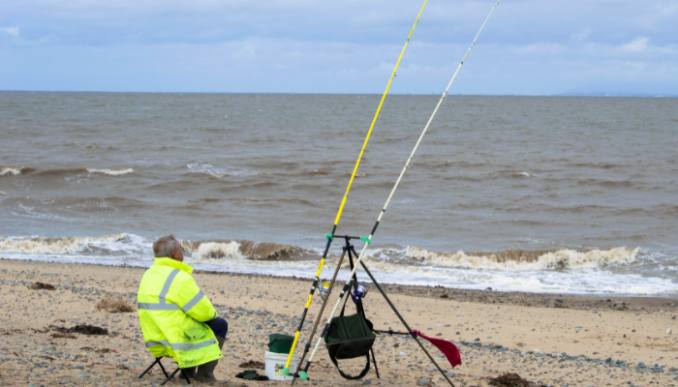E-Newsletter Signup
For special offers, updates and news of new products join our newsletter.
- Also in Blogs
- Sustainable Camping: Preserving Nature for Future Generations
- Embracing the Renewal of Spring: Camping Adventures Await.
- Beating The Winter Blues!
- The History of Cycling
- Senior Camping: Young at Heart
- View all posts in this category >>
GUEST BLOGGER
If you would like to contribute to our blog as a guest and can bring fresh outdoor experiences, please:
Sea Fishing: Whatever the Weather?
Posted in Blogs on 3rd August 2023
This summer’s turbulent weather has had a significant impact on sea fishing. Inconsistent weather, and particularly the wind direction, affects the behaviour of fish and consequently the success or failure of your trip.

© Michael J P / Shutterstock.com
The weather across Britain has been particularly inconsistent this year, in complete contrast to the long heat wave of June and July 2022, when temperatures hit a record high of 40°C.
In June of this year, the temperature peaked at 32°C in southeast England. This was the hottest temperature for June since records began in 1846.
However, throughout July, it has been what’s best described as mediocre weather-wise, with consistent showers persisting throughout the month. The peak temperature has been only 22°C in July and this has dropped as low as 14°C at times.
Experienced sea anglers will always check the weather report before organising a summer fishing trip, as it will have an impact on the fish they are targeting and the methods they can use.
Sea conditions and wind direction
Sea conditions and the wind direction will influence whether fish are present in the casting area of anglers on the shore. Find the best sea fishing spot by checking the weather and state of the sea for a few days before heading off.
An onshore wind coming in off the sea stirs up the seabed, causing rough and choppy waves, or even wild and stormy waves if the gusts are particularly strong. This will dislodge shellfish such as limpets, mussels and cockles from their home on rocks. It will also disturb marine worms from their burrows and force small fish, crabs and other marine creatures out of weed beds.
Larger fish will move inshore to the shallower water to access this convenient source of food. This can benefit sea anglers greatly.
While it’s not advisable to fish in storm conditions for practical and safety reasons, if you go straight after a storm this can be an extremely productive time. A lot of food will have been dislodged in a storm, attracting even more large fish from the deeper offshore waters.
An offshore wind creates a calmer sea, so there will be few shellfish dislodged near the shore to entice the larger fish to feed on. They will often head out to deeper waters, out of range of shore anglers, in these conditions.
The majority of catches close to the shore will usually include whiting and cod, as they will be more likely to move out of the rock cover and weed beds to feed freely when the larger predatory fish aren’t around.
The ideal bait
Pay attention to the different food sources that are released by the weather. For example, if mussels dislodged by the storm are prevalent in the fishing area, it’s sensible to use them as bait, as the larger fish will already be feeding on them.
If you see lugworms scattered around the sandy beach following rough weather, these will also be an ideal bait to use. In most circumstances, if a large amount of a particular food type has been dislodged due to stormy weather, it will be spread about the feeding area.
It’s quite common to find fish are already feeding exclusively on this food source, so using high-quality fresh bait of the same type can be very important during these periods. The fish may ignore poor quality alternatives, as they will have plenty of food to choose from already.
Never go sea angling in very rough conditions, tempting as it may be, as your safety always comes first. Fishing from rocks and piers can be dangerous when big waves and swells come rushing over them if the sea is very rough.
Settled water can bring some good results for angers, as plaice, wrasse, pollock and mackerel will be tempted nearer the shore when the sea is calmer and warmer in summer.
Fishing in the rain
While fish are largely oblivious to a downpour, it can make the whole experience a lot less comfortable for sea anglers.
Wear protective clothing even in summer to keep the wind and rain at bay. Even on a summer evening, a sudden downpour can ruin the trip if you’re wearing wet clothes.
On rare occasions, very heavy rain and inland floods can send a large amount of fresh water rushing into the sea. This can drive away sea fish, apart from flounders, which can live in water with a low salinity level. However, there would need to be an exceptionally high level of freshwater pumping into the sea to create any real issues of this kind.
Fishing in the summer sun is more enjoyable for anglers than it is for fish. Just like most living creatures, fish aren’t fond of stifling midday heat. If the sun is beating down on the waves, the fish will usually retreat to a lower depth to seek out cooler water.
You can go sea fishing whatever the weather, as long as it’s safe to do so, but generally speaking, the best time for fishing is just before windy weather or a storm moves in, as the fish are more active in a period of low pressure that precedes the bad weather.
Best fishing spots
Choose your location carefully, depending on what type of fish you’re aiming to catch. For example, cod can commonly be found in a rough sea, with a good surf or swell.
If you’re hoping to catch tuna, yellowtail, or any other surface-feeding fish, look for birds and baitfish to give you an idea where to set up. If you’re looking for rockfish, snapper or grouper, find a structure such as a reef, wreck, or other anomaly and they’re likely to be there.
Do your research on the habitat of your target species. Then go to the relevant rocky area, sandy flats or offshore reef, safe in the knowledge this will probably be a good spot.
Rods and reels
Determine the best sea fishing setup in advance of your trip and don’t leave it to chance.
The WSB Tackle Overshadow 8000 is a great beach casting reel, offering advantages such as a line roller, two ball bearings, powerful front drag and an ambidextrous handle. Complete with 350 yards of 15lb monofilament line, this provides great casting ability and strong retrieval power when winding in.
The 12 ft WSB Tackle Overshadow Beachcaster rod is highly versatile, enabling comfortable handling. Incredible value, it is well balanced with a progressive casting action. The excellent bite registration is ideal for clean and mixed ground beaches.
It can launch 4oz to 8oz weights, along with a sizeable bait. Designed to be used with a fixed spool reel, we recommend the Overshadow 8000 to create a great combination that delivers perfect comfort while casting and landing some memorable fish.



